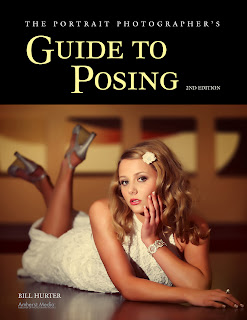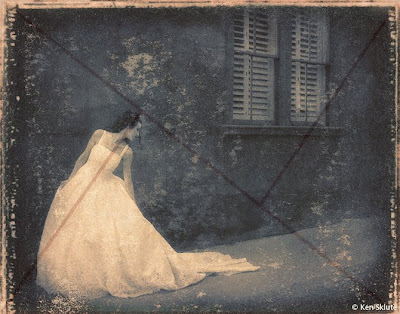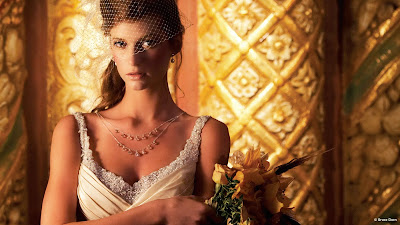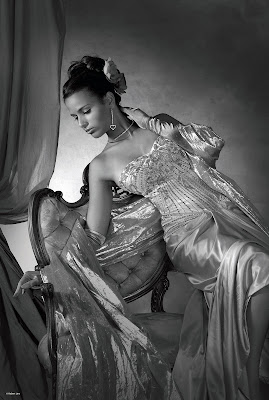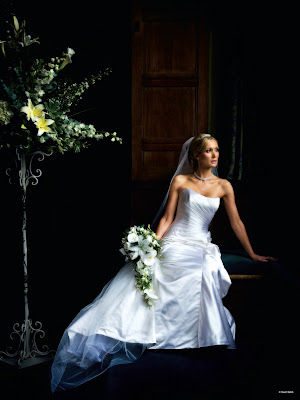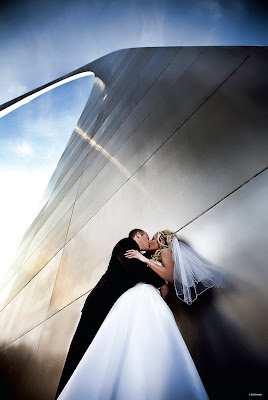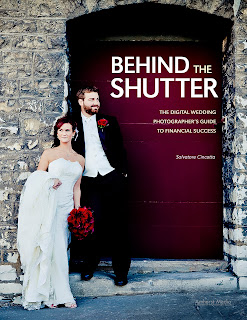
Today's post is an excerpt from the book Behind the Shutter: The Digital Wedding Photographer's Guide to Financial Success. It is available from Amazon.com and other fine retailers.
Now you have this wonderful business plan, but how do you get started booking weddings? Bridal shows are the best way to get your work out in front of a lot of brides very quickly. In addition, they allow you to begin networking with your industry peers. However, like all things, you need to have a plan. Just showing up with some prints and an album and expecting a windfall of cash . . . well, that borders on the realm of fantasy. Imagine your toughest job interview, then multiply it by ten. That will put you close to understanding the intensely competitive nature of a bridal show.
I get all sorts of feedback on the effectiveness of bridal shows. If you talk to ten photographers, somehow you’ll get ten different opinions on the subject. For us, bridal shows are the source of about 65 percent of our bookings. Yes, we have referrals, but bridal shows allow us to showcase our work to a much wider audience. I love them—I love the energy they bring, and I love being able to create a fan base for our work.
FINDING THE RIGHT SHOW
These days, bridal shows are like gas stations—they are everywhere. As a result, to a certain extent brides are getting burned out on them and becoming numb to the hard sell. Therefore, finding the right show is paramount, and defining “right” is equally important. Once you understand your target demographic and price points, you will have a good idea of your target bride. Is she the younger bride or the thirtysomething woman? Is she an elite bride spending $100,000 on her wedding or is she more in the mid-range? These are important questions to answer and should be part of your business and marketing plan.
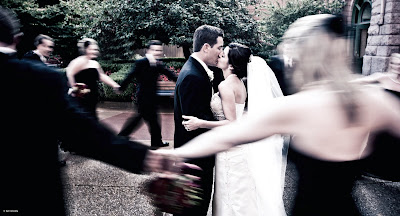
Armed with this information, you will be better able to identify the right show for you. Start by doing a web search for shows in your area. I would be looking at the top ten to fifteen shows. Think about it this way: How are brides finding out about shows? I would bet that the majority of them are searching online. So if you can’t find the show online, how will they? Not every show will have a major web presence, but it certainly helps.
Now, take that list of shows and start reviewing their web sites to see if they have a section for vendors. There, you may find a media kit of sorts. In that media kit, you often have access to very valuable information—in particular, the demographics of their attendees. If not, pick up the phone and call the promoter. They are usually more than willing to talk to you about their show and what to expect.
If all else fails, ask other vendors what they think of the show. Be careful with this approach, though. A vendor’s success or failure at these events depends on many factors, including their ability to sell themselves and their product. So don’t just ask generic questions such as, “Did you like the show?” or “How many events did you book?” Instead, ask more specific and objective questions about how many brides attended, what the caliber of the brides was, etc.
One of the next things I tend to think about is attendance. I have been doing this long enough to know that with so many shows out there, getting the attention of the bride is not easy. And remember that pesky COA number we spoke about in the first chapter? The more brides that attend a show, the better your odds of booking more than one bride, and the better your COA number will be. (BLOG NOTE: As this blog post is an excerpt from a larger work, you will need to purchase the book to access chapter 1 and the information it contains.)
Also, how are the promoters advertising the show? Some of the larger shows are tied to a magazine. This is key for me; knowing that the magazine has a certain distribution assures me that the show should have a built-in audience. This is a good sign for sure.
Once you feel confident that the show is attracting the brides you want to book, the next thing to consider will be the price of admission. Not all shows and budgets are created equally. Our first year, we did several of the less expensive shows, and guess what? We booked low-budget, high-maintenance brides. Today, we focus more on the middle market. However, our pricing is on the higher end of the market for the Midwest. The reason I like to focus on the middle market is because it gives us access to the greatest number of brides. Brides who truly appreciate what we do will be willing to spend more on a photographer. Sure, we love our high-end clientele, but there is nothing more satisfying than working with a client who had to stretch a little to work with you because they love what you do.
In addition, we went from a single booth back in 2007 to a double booth at almost every show today. I love being able to showcase my work in a way that really stands out—and having that double booth really sets us apart from the rest.

GETTING PREPARED
Now that you have decided to participate in the show, the real fun begins. Preparing for a bridal show is never easy. In fact, I will never forget my first bridal show. I was so nervous that we would fail and our work would be rejected that I wanted to pull out the night before (and for anyone who knows me, confidence is not something I lack!). I don’t know what it was; I just had so much anxiety about the whole thing. My wife, being the amazing supporter that she is, pushed me to stick with it and, sure enough, it was a huge success for us. Within a week, we booked twelve weddings from that show. It was unreal and it opened my eyes to the impact these shows would ultimately have on our business and our future.
Displays and Samples. You have to understand your brides and understand what they are looking for. If they are going to shell out thousands of dollars to work with you, they want your creativity, energy, and artistic talent. And believe it or not, they often make up their minds about you within thirty seconds of setting foot in your booth. The way you dress, the pictures you are showcasing, your sample albums, the look and feel of your booth—these factors are all in play.
We want our clients to lust for our brand. We accomplish this by ensuring that everything we do is of the highest quality. We invest in having the right products to show. After all, you can’t sell it if you don’t show it. Don’t underestimate the importance that this will have on your overall success at the shows.
Here’s my first bit of advice: don’t show up at a bridal show with small prints. Remember, you are a photographer and you sell imagery! Every year, I see a new crop of photographers wanting to make it, and this is the one area where they all seem to fall flat on their faces. My feeling is that small images are something the client thinks they can produce on their own; they regard small prints more as snapshots than professional, high-quality images. Ask yourself: Are you trying to sell small images? Or do you want your potential clients to see you as an artist? Do you want them to fantasize about seeing themselves in one of your masterpieces? I sell vision. I sell art. I sell an experience. And none of that comes in an 8x10-inch package.
So go big! Make a statement and give them something to remember you by. Show them your top five or ten “statement” images—those shots that really get a bride to say, “Wow! I want that for my wedding day.” Yes, things like detail images are important to showcase in your overall portfolio, but I have never booked a bride who said, “Yep, that’s the best shoe photo I have ever seen. This guy is for me!”
Albums are one of the main products through which we differentiate ourselves from the competition. Therefore, we invest a lot of time and energy in ensuring that we have unique styles for brides to choose from. We carefully select styles that represent our brand and the overall design we are trying to sell. We are a very modern brand, so we strive for simplicity in our album designs—we don’t put 150 images in a twenty-page album. Because we don’t show albums designed this way, we don’t get clients who expect this. If you don’t have albums, go and make the investment. If you haven’t updated your samples in more than two years, guess what? It’s time to bite the bullet and get some new samples. There’s really no excuse; almost all album manufacturers make it simple for you to get an updated sample album at a 40 to 50 percent discount.
Your Attire. The last thing I want to cover regarding being prepared is your attire. I know it’s a strange thing to discuss in a business book, but the adage is true: you have to dress for success. Brides (at least the ones I’m going after) tend to be very fashion-oriented. If we want them to spend money and care about the way they look in pictures, we need to care how we look, too.
I am not suggesting you dress in a way that is not you. But, again, this is like a job interview. Yes, they are judging you and, yes, it’s pretty superficial. Trust me—I understand that our imagery is not tied to the way we dress. However, this is the world we live in and my goal is to remove any barrier that would prevent a couple from booking us. I want them to be able to relate to us and ultimately book us for their event.
WHAT TO EXPECT
Now that you are ready for the big show, you should have set some goals for yourself. We go into every show with reasonable expectations. At an average show, we want to book about four to five weddings to make the numbers work.
Understand Your Objectives. Going into the show, we know that it’s going to be intense, so we ratchet up the energy level. At one of the best shows in our area, there are about 1500 brides in attendance. I know one thing: I don’t want to book 1500 weddings. We are looking for approximately ten brides in the sea of couples—ten brides who get what we do, ten couples who identify with our brand and our style. This is a daunting task. We’re talking about homing in on less than 1 percent of the brides.
How do I focus in that tightly? I don’t. My hope is that all the work I did to prepare my booth will pay off by naturally attracting the right brides. Is that always the case? No, of course not—but it helps for sure. I have no idea who those “right” brides are or what they look like, so we treat every client who walks up like they are the only client there. There are two of us in the booth and we split up to ensure we are connecting with as many people as possible. And trust me when I tell you this: even if you don’t get to speak to someone one-on-one, they are hanging around in the background listening to your sales pitch. So make sure it’s solid.
Sell Yourself. In general, photographers are not salespeople and tend to be a little more introverted. If this is something you need to work on, be sure to do it. Practice—yes, I said practice. Talk to yourself in a mirror if you have to. Listen to yourself deliver your pitch. Does it sound natural or does it come off as rehearsed? Be honest with yourself or ask someone else to listen. Sure, it seems stupid—but I am an author, a lecturer, and an active photographer, and I still talk to myself. (I’m not sure what that says about me, but that’s another story.)
When I am talking about your sales pitch, I am not asking you to be super salesperson. You just have to be able to present your business effectively to someone in about thirty seconds. You need to tell them why they should choose you and what makes you different from every other photographer in the room. While no one may ask you those questions directly, you can bet that’s what it comes down to, so be sure your pitch clearly communicates your value proposition. (And now we have a new term: value proposition. This is a term used to describe the unique benefits you offer to prospective clients.)
Provide an Incentive. At some bridal shows, we like to collect names. To entice the brides to register, we have an item we are raffling off. It could be a free engagement session, a slide show, or some other product. Generally, brides are more than willing to give you this information—and some even come prepared with sticky labels that have all their information printed on them.
We have a big glass bowl and a sign-up pad where people can leave their information. This information is a gold mine for leads. We typically collect 150 to 300 names from a good show. We then use these leads to send out an e-mail blast to everyone who stopped by our booth. This keeps us fresh in their minds and usually generates another four to six meetings with brides.
JUMP IN!
Now, let’s get those fingers typing. Check for bridal shows in your local area and get ready to jump in with both feet. The first show will be your toughest, but if you invest the required time and money and do your homework, you will be well on your way to finding success in the wedding industry.
Buy this book from Amazon.
